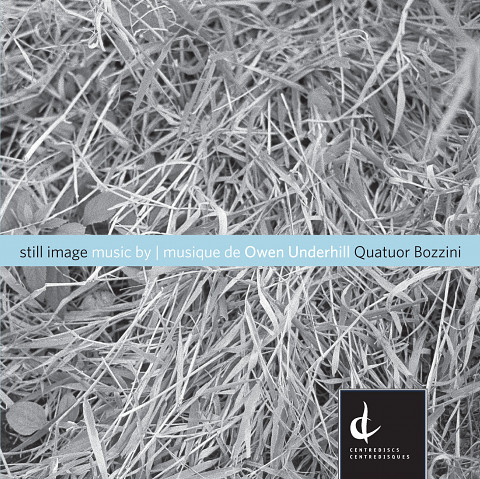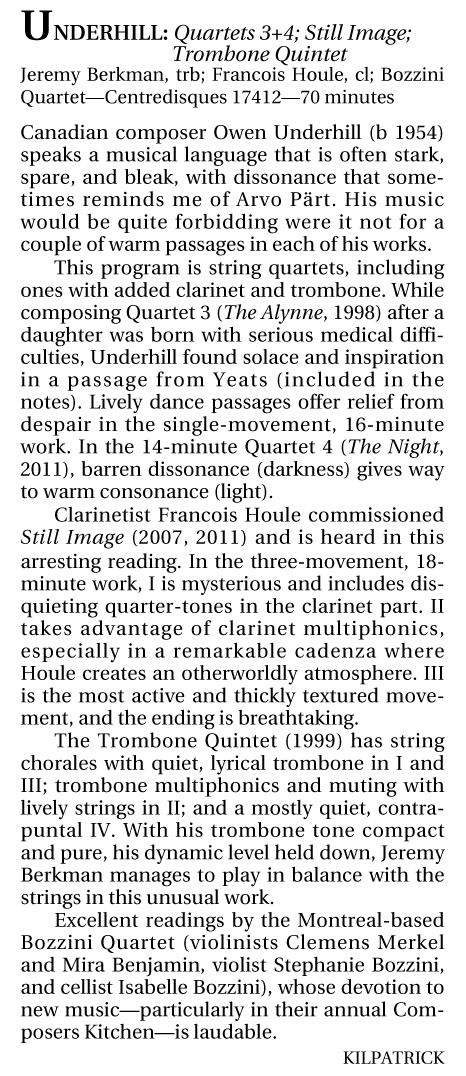Review
In many ways, this is an intimate recording of intimate music. Still Image is a recording of two quartets and two quintets, which brings the obvious intimacy of chamber music. It is recorded and mastered to sound like a salon, giving the players a real presence and immediacy. These intimacies compliment Owen Underhill’s music, which draws the listener into intimate spaces made up of almost familiar gestures balanced against ear-catching and varied glimpses outside those expectations, by way of pitches, timbres, or harmonies.
New music fans may know Owen Underhill as the artistic director of Vancouver New Music from 1987-2000 or, more recently, as co-artistic director of Vancouver’s Turning Point Ensemble. This CD presents four works by Underhill, a string quartet (2011), a clarinet quintet (2007/11), an older string quartet (1998), and a trombone quintet (1999). The CD is anchored by the Quatuor Bozzini, a renowned quartet based out of Montréal with an extensive and impressive track record in North America, Europe and beyond. The quartet is joined by clarinetist Françcois Houle and trombonist Jeremy Berkman.
The CD opens with String Quartet #4 “The Night,” which was commissioned by the Bozzini Quartet for the recording. This is my favorite work on the album—a single movement work made up short passages of varied textures punctuated with string harmonics. This quartet evinces the balancing of the almost familiar with restive excursions that hold the ear, but the brevity of the sections brings various manifestations of those tendencies into a prismatic juxtaposition: now scurrying sul pont. gestures over simple pizzicato bass, then an aqueous passage of tremolos and ephemeral lines, then an ascetic chorale, each resolving in turn to the nearly-cadential but equally varied passages of string harmonics. At times evocative of Bartók’s folkloricism, at times fleetingly reminiscent of Black Angels, the work shows a disciplined ear behind the sectional form and kaleidoscopic surface.
The clarinet quintet, Still Image, opens with a striking use of the harmonic nodes along a single string on the violin, reminiscent of an Aeolian harp. The clarinet, played by François Houle who originally commissioned the work, blends fluidly with the strings. The first movement is infused with elegant, dolorous augmented seconds, giving an impression of a kind of slow, lacquered klezmer. The second movement features a play of timbres in the clarinet, moving into melismatic passages that reminded me of Moroccan sufi music and evolving into a cadenza in the middle of the work with some multiphonics exquisitely handled by Houle. The third movement is also inventive and restless, concluding with a high, florid meditation among the strings and clarinet.
Underhill’s third string quartet, subtitled The Alynne, was composed shortly after the birth of the composer’s daughter, Alynne, and is also a single-movement work. The piece exhibits the strongest folkloric tendencies on the disc, evoking fiddling, a kind of “Appalachian” open sound and furtive appearances of the Aeolian harp. In my notes on the work, I jotted “like Copland crossed with the Kronos [Quartet] catalog,” and while that scribble draws on caricatures of Copland and Kronos, it transmits an accurate impression of the sonic palette in the work. Even here, within these seemingly familiar sounds, Underhill surprises the ear with pitches and timbres that perturb the prevailing background. There is an exquisite viola solo in the middle of the first third of the piece. Like the fourth quartet, the middle third of the piece is bookended with sine-wave-like harmonics.
The last work is the Trombone Quintet from 1999. Here, the soloist is Jeremy Berkman, the trombonist who originally commissioned the work. The first three movements maintain a single mood throughout: the first movement presents elegiac trombone lines over a chorale in the quartet; the second offers light and playful string lines with the trombone played with what sounds like harmon mute with plunger, creating a kind of “mouth harp” effect, which is often paired with quiet humming or singing for (I suspect) the trombonist; the third returns to a hymn-like texture in the strings with the trombone uttering elegies among them. The fourth movement foreshadows String Quartet #4 in some ways, constructed from shorter passages that are juxtaposed in succession. However, the later quartet displays a confident economy and a playfulness only hinted at in the trombone quintet. This work, like the third quartet that immediately precedes it on the disc, ends quietly with string harmonics and with a (perhaps signature) Aeolian-harp effect.
Taken as a whole, this CD presents a solid compositional voice from Underhill and showcases excellent musicians out of Canada. Listeners who are excited mainly by timbral invention will probably find the disc a bit staid, but they would be missing the point: Underhill is clearly more interested in an intimate palette of pitch and formal exploration, of endlessly teasing the expectations of pitch and sometimes timbre established by almost-familiar gestures and pitch schemes. If I had any complaint, it would be that presenting the four works together brings out a proclivity for high string harmonics, which becomes slightly taxing when listening to the entire CD, but we all have ticks that are exposed when our works are presented in a concentrated dose. As this is the first review of either Quatuor Bozzini or Owen Underhill on this blog, this CD serves as an engaging and beautiful introduction to their work and I look forward to hearing more from both of them.


